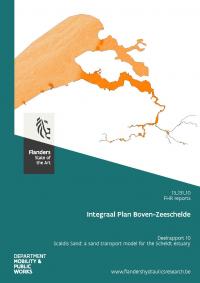Gedaan met laden. U bevindt zich op: Integraal Plan Boven-Zeeschelde. Sub report 10. Scaldis Sand: a sand transport model for the Scheldt estuary
Integraal Plan Boven-Zeeschelde. Sub report 10. Scaldis Sand: a sand transport model for the Scheldt estuary
De Vlaamse Waterweg NV (DVW) wants to improve the navigability of the Upper Sea Scheldt allowing navigability up to Class Va while increasing safety for ships of class IV and lower. An integrated plan was made that aims at further developing the conclusions from a feasibility study towards Class Va shipping. It is of the utmost importance that the design of this enlargement leads to a multifunctional Scheldt with assets for navigability, guarantees for protection against flooding and a sustainable natural system.
This report present a sand model for the Scheldt estuary, that is part of a model chain to evaluate different geometrical scenarios. The behaviour of non-cohesive sediments is important in the assessment of the impact of changes in bathymetry or management of the estuary and for this project, the Upper Sea Scheldt in particular.
The sand model is coupled with a TELEMAC-3D model Scaldis, developed earlier in the project. The sand model itself uses a single fraction of sand with a D50 value of 150 μm. The Engelund and Hansen equation was chosen as total load transport equation. The bottom of the hydrodynamic model was not updated with bed level changes from the sand model.
Model results show good agreement with point measurements for some locations (Oosterweel and Dendermonde) and less agreement with other locations (Driegoten and Schoonaarde). Sand transport over different transects along the Scheldt estuary was calculated and compared with calculated transport rates based on bathymetric surveys between 2001 and 2010 and on lithological information. For the Upper Sea Scheldt the model reproduces the calculated results very well. The model underestimates sand transport in the Lower Sea Scheldt compared to the calculated transports and gives opposite directions of transport.
Finally an overview of net sand transport over different transects along the Scheldt estuary is given and linked to the tidal asymmetry of the cross-sectionally averaged flow velocity to the power five (as used in the Engelund Hansen formula).

Lees de publicatie
- Publicatiedatum
- November 2019
- Publicatietype
- Onderzoeksrapport
- Thema's
- Scheepvaart en havens
- Auteur(s)
- S. Smolders, B. De Maerschalck, Y. Plancke, J. Vanlede, F. Mostaert
- Reeks
- FHR reports 13_131_10